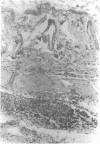Abstract
The presence of particular surface carbohydrate modifications is shown to affect dramatically the stability and tissue specificity of unilamellar distearoyl phosphatidylcholine vesicles in mice. Use of the gamma-ray probe 111In3+ permits analysis of tissue distributions by standard gamma counting techniques and determination of the structural integrity of the vesicles by perturbed angular correlation spectroscopy. Addition of a 6-aminomannose derivative of cholesterol to the lipid bilayer produces initial retention of high levels of intact vesicles in the lung after intravenous injection followed by concentration of intact vesicles in the liver and spleen. Vesicles bearing 6-aminosugar residues are found to concentrate in the axillary space in aggregates of polymorphonuclear leukocytes when administered subcutaneously. The in vivo stability of 6-aminomannose-labeled vesicles is substantially greater after intravenous or subcutaneous administration than that observed for any other system examined. The dose-response effects observed with surface modifications indicate that a particular receptor topography is important in the mechanism leading to transport and destruction of these vesicles.
Full text
PDF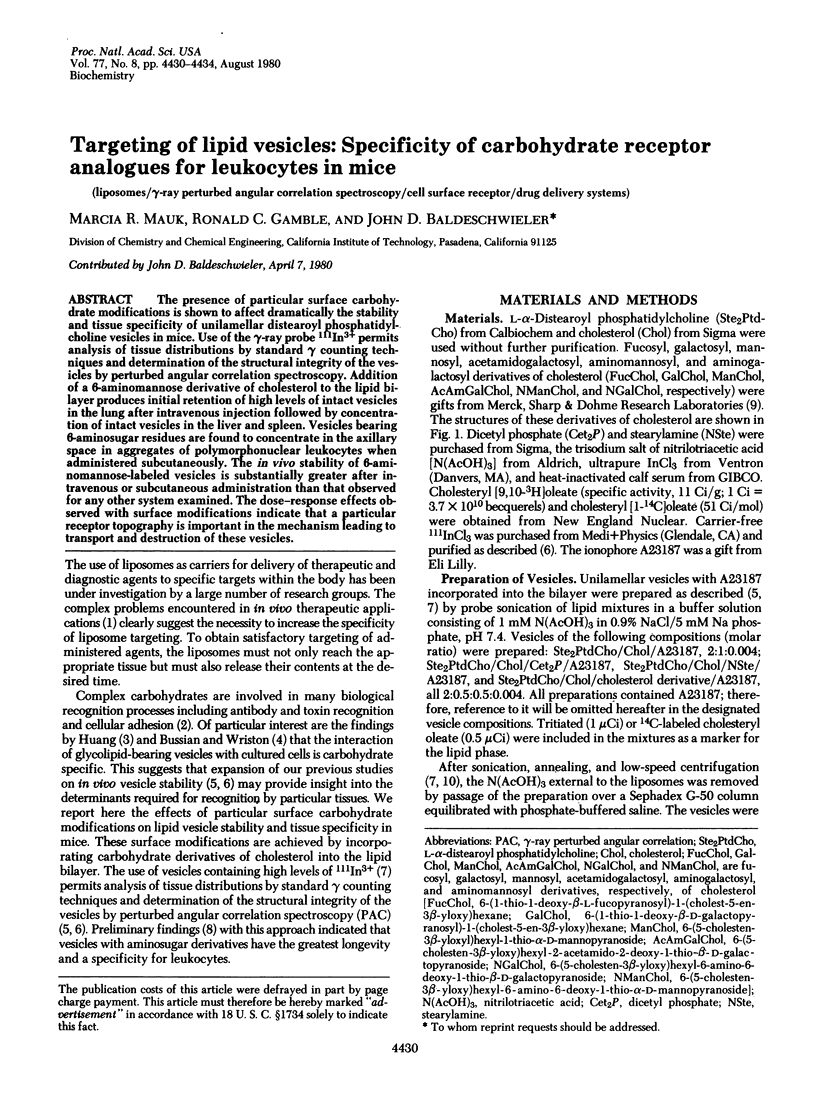
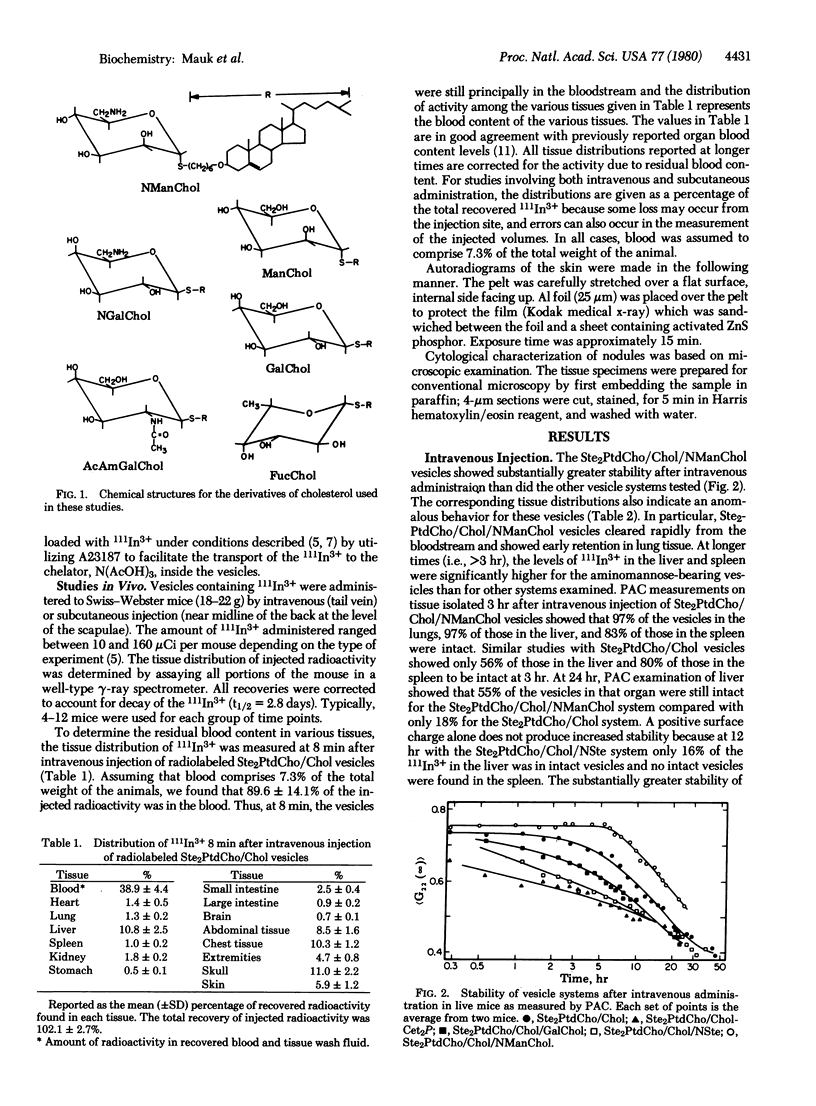
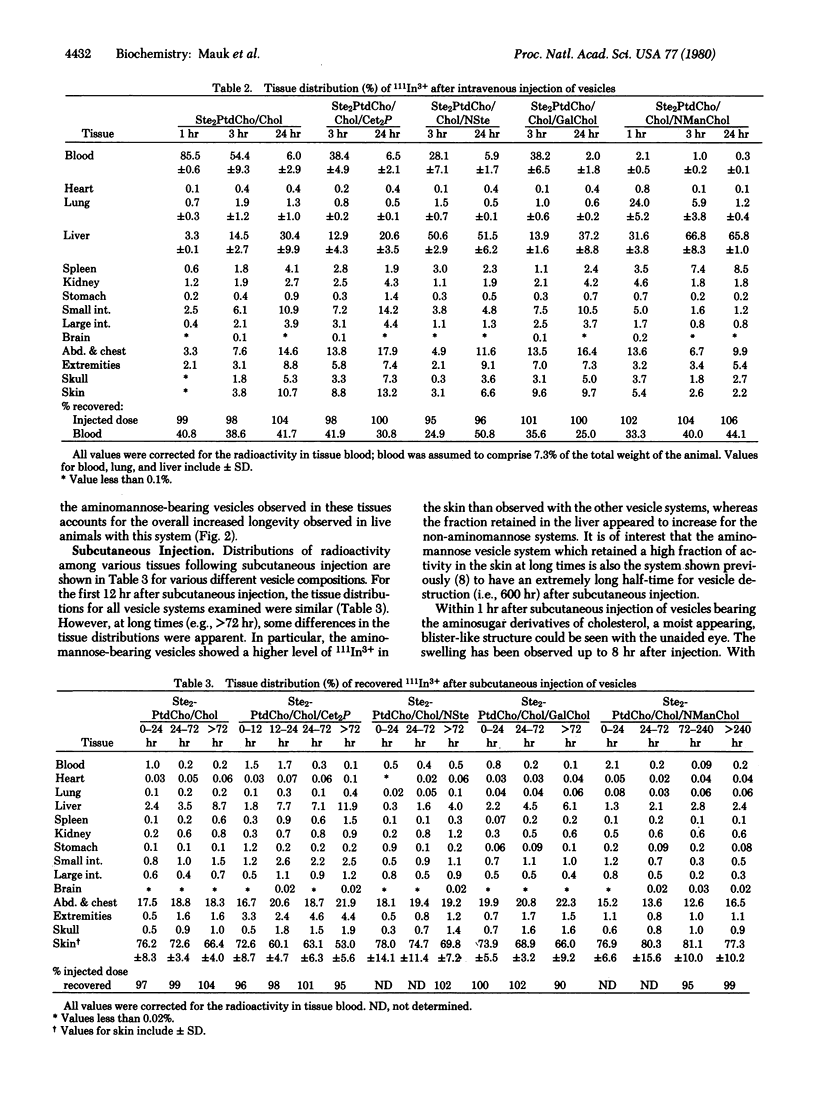
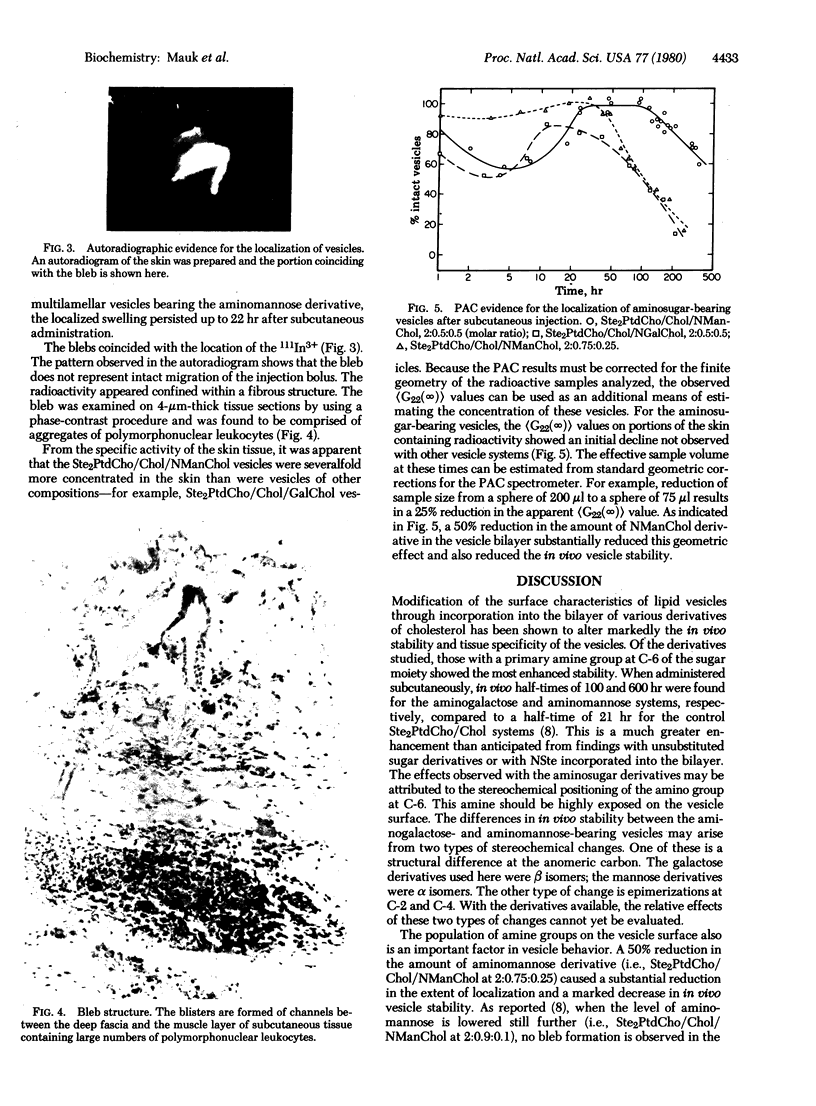
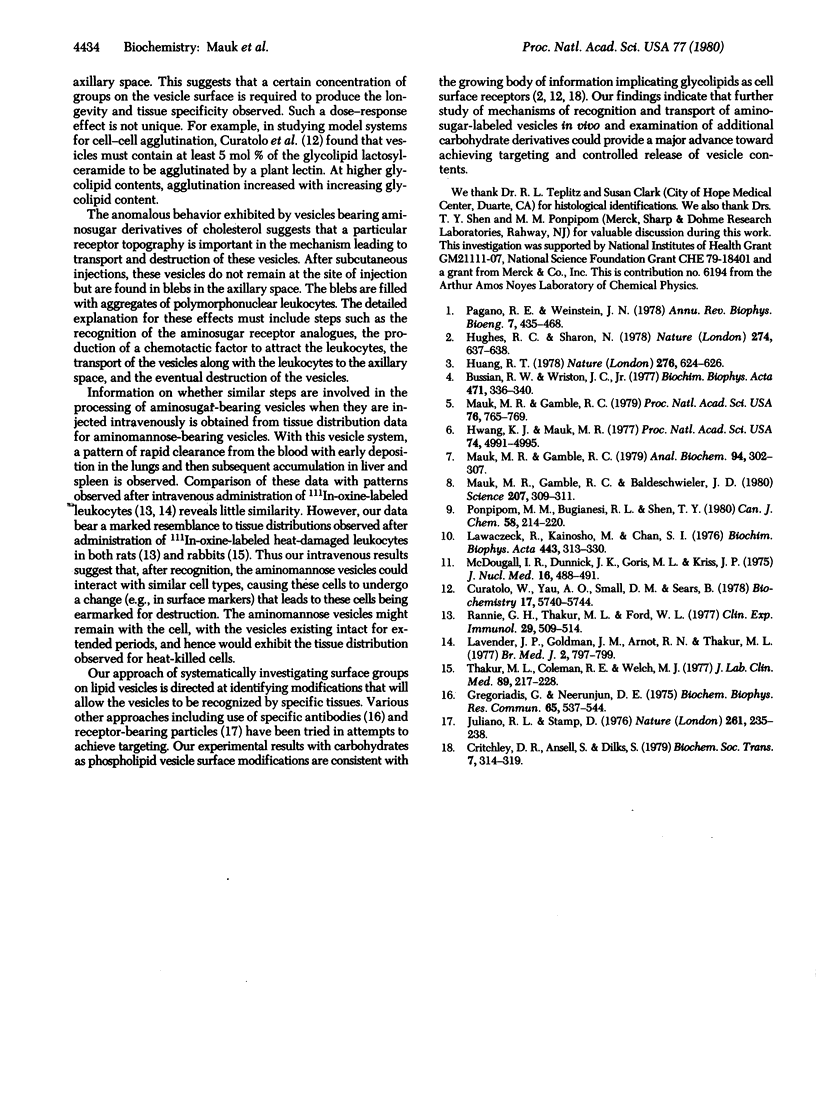
Images in this article
Selected References
These references are in PubMed. This may not be the complete list of references from this article.
- Bussian R. W., Wriston J. C., Jr Influence of incorporated cerebrosides on the interaction of liposomes with HeLa cells. Biochim Biophys Acta. 1977 Dec 1;471(2):336–336. doi: 10.1016/0005-2736(77)90261-9. [DOI] [PubMed] [Google Scholar]
- Critchley D. R., Ansell S., Dilks S. Glycolipids: a class of membrane receptors. Biochem Soc Trans. 1979 Apr;7(2):314–319. doi: 10.1042/bst0070314. [DOI] [PubMed] [Google Scholar]
- Curatolo W., Yau A. O., Small D. M., Sears B. Lectin-induced agglutination of phospholipid/glycolipid vesicles. Biochemistry. 1978 Dec 26;17(26):5740–5744. doi: 10.1021/bi00619a022. [DOI] [PubMed] [Google Scholar]
- Gregoriadis G., Neerunjun E. D. Homing of liposomes to target cells. Biochem Biophys Res Commun. 1975 Jul 22;65(2):537–544. doi: 10.1016/s0006-291x(75)80180-x. [DOI] [PubMed] [Google Scholar]
- Huang R. T. Cell adhesion mediated by glycolipids. Nature. 1978 Dec 7;276(5688):624–626. doi: 10.1038/276624a0. [DOI] [PubMed] [Google Scholar]
- Hughes R. C., Sharon A. Carbohydrates recognised. Nature. 1978 Aug 17;274(5672):637–638. doi: 10.1038/274637a0. [DOI] [PubMed] [Google Scholar]
- Hwang K. J., Mauk M. R. Fate of lipid vesicles in vivo: a gamma-ray perturbed angular correlation study. Proc Natl Acad Sci U S A. 1977 Nov;74(11):4991–4995. doi: 10.1073/pnas.74.11.4991. [DOI] [PMC free article] [PubMed] [Google Scholar]
- Juliano R. L., Stamp D. Lectin-mediated attachment of glycoprotein-bearing liposomes to cells. Nature. 1976 May 20;261(5557):235–238. doi: 10.1038/261235a0. [DOI] [PubMed] [Google Scholar]
- Lavender J. P., Goldman J. M., Arnot R. N., Thakur M. L. Kinetics of indium-III labelled lymphocytes in normal subjects and patients with Hodgkin's disease. Br Med J. 1977 Sep 24;2(6090):797–799. doi: 10.1136/bmj.2.6090.797. [DOI] [PMC free article] [PubMed] [Google Scholar]
- Lawaczeck R., Kainosho M., Chan S. I. The formation and annealing of structural defects in lipid bilayer vesicles. Biochim Biophys Acta. 1976 Sep 7;443(3):313–330. doi: 10.1016/0005-2736(76)90032-8. [DOI] [PubMed] [Google Scholar]
- Mauk M. R., Gamble R. C., Baldeschwieler J. D. Vesicle targeting: timed release and specificity for leukocytes in mice by subcutaneous injection. Science. 1980 Jan 18;207(4428):309–311. doi: 10.1126/science.7350660. [DOI] [PubMed] [Google Scholar]
- Mauk M. R., Gamble R. C. Preparation of lipid vesicles containing high levels of entrapped radioactive cations. Anal Biochem. 1979 Apr 15;94(2):302–307. doi: 10.1016/0003-2697(79)90364-6. [DOI] [PubMed] [Google Scholar]
- Mauk M. R., Gamble R. C. Stability of lipid vesicles in tissues of the mouse: a gamma-ray perturbed angular correlation study. Proc Natl Acad Sci U S A. 1979 Feb;76(2):765–769. doi: 10.1073/pnas.76.2.765. [DOI] [PMC free article] [PubMed] [Google Scholar]
- McDougall I. R., Dunnick J. K., Goris M. L., Kriss J. P. In vivo distribution of vesicles loaded with radiopharmaceuticals: a study of different routes of administration. J Nucl Med. 1975 Jun;16(6):488–491. [PubMed] [Google Scholar]
- Pagano R. E., Weinstein J. N. Interactions of liposomes with mammalian cells. Annu Rev Biophys Bioeng. 1978;7:435–468. doi: 10.1146/annurev.bb.07.060178.002251. [DOI] [PubMed] [Google Scholar]
- Rannie G. H., Thakur M. L., Ford W. L. An experimental comparison of radioactive labels with potential application to lymphocyte migration studies in patients. Clin Exp Immunol. 1977 Sep;29(3):509–514. [PMC free article] [PubMed] [Google Scholar]
- Thakur M. L., Coleman R. E., Welch M. J. Indium-111-labeled leukocytes for the localization of abscesses: preparation, analysis, tissue distribution, and comparison with gallium-67 citrate in dogs. J Lab Clin Med. 1977 Jan;89(1):217–228. [PubMed] [Google Scholar]




